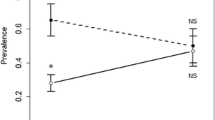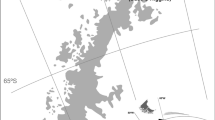Abstract
The crested porcupine Hystrix cristata is a large body-sized rodent, occurring in Europe only in the Italian Peninsula, where it may have been introduced in early Medieval times. Its parasite fauna is currently poorly known and limited to few anecdotal observations. We have analyzed the ectoparasite load of 165 crested porcupines from Tuscany and Latium (Central Italy). Both captured and road-killed individuals were checked for fleas and ticks. Overall, only 39 porcupines were infested by four species of ticks and five of fleas. Abundance of ectoparasites was higher in areas with higher habitat richness, with respect to densely wooded areas. The most frequent species was the flea Pulex irritans (25 %), whose prevalence peaked in winter probably because of optimal abiotic conditions in the porcupine’s den. The remaining species of both hard ticks (Rhipicephalus bursa, Pholeoixodes hexagonus, and Ixodes ventalloi) and fleas (Paraceras melis, Ctenocephalides canis, Dasypsyllus gallinulae, and Hystrichopsylla talpae), all with prevalence lower than 5 %, could be due to den sharing with other vertebrates, mainly carnivores such as, e.g., red foxes and badgers. The second most prevalent species was the generalist tick Ixodes ricinus (21 %). An adult male-biased parasitism for ticks has been detected, suggesting a possible role of testosterone related immune-depressive effect. The low richness in dominant ectoparasite species, built up by locally acquired generalist taxa, provides support to the allochthonous origin of this rodent in Italy.

Similar content being viewed by others
References
Altizer S, Nunn CL, Thrall PH, Gittleman JL, Antonovics J, Cunningham AA, Dobson AP, Ezenwa V, Jones KE, Pedersen AB, Poss M, Pulliam JR (2003) Social organization and parasite risk in mammals: integrating theory and empirical studies. Annu Rev Ecol Evol Syst 34:517–547
Ancillotto L, Mazza G, Menchetti M, Mori E (2014) Host specificity of the badger’s flea (Paraceras melis) and first detection on a bat host. Parasitol Res 113:3909–3912
Bailly-Choumara H, Morel PC, Rageau J (1976) Sommaire des données actuelles sur les tiques du Maroc (Acari, Ixodoidea). Bull Ins Sci 1:102–117
Bates JK, Rothschild M (1962) Field studies on the behaviour of bird fleas. I. Behaviour of the adults of three species of bird fleas in the field. Parasitology 52:113–132
Beaucournu JC, Launay H (1990) Les puces de France et du bassin Méditerranéen occidental. Faune de France 76. Fédération Française des Sociétés de Sciences Naturelles, Paris
Berlinguer G (1965) Aphaniptera d'Italia. Studio Monografico. Il Pensiero Scientifico Editors, Rome
Bordes F, Blumstein DT, Morand S (2007) Rodent sociality and parasite diversity. Biol Lett 3:692–694
Buckland P, Sadler J (1989) A biogeography of the human flea, Pulex irritans L. (Siphonaptera: Pulicidae). J Biogeogr 16:115–120
Corlatti L, Bethaz S, von Hardenberg A, Bassano B, Palme R, Lovari S (2012) Hormones, parasites and male mating tactics in Alpine chamois: identifying the mechanisms of life history trade-offs. Anim Behav 84:1061–1070
Corsini MT, Lovari S, Sonnino S (1995) Temporal activity patterns of crested porcupines Hystrix cristata. J Zool, London 236:43–54
Cox R, Stewart PD, Macdonald DW (1999) The ectoparasites of European badger, Meles meles, and the behaviour of the host specific flea, Paraceras melis. J Insect Behav 12:245-265
Gubernick DJ, Alberts JR (1987) The biparental care system of the California mouse, Peromyscus californicus. J Comp Psychology 101:169–177
Hoogland JL (1979) Aggression, ectoparasitism, and other possible costs of prairie dog (Sciuridae, Cynomys spp.) coloniality. Behav 64:1–35
Hughes VL, Randolph SE (2001) Testosterone depresses innate and acquired resistance to ticks in natural rodent hosts: a force for aggregated distributions of parasites. J Parasitol 87:49–54
Johnson VE (2013) Revised standards for statistical evidence. Proc Natl Acad Sci U S A 110:19313–19317
Kinsella JM, Pattie DL (1967) Ectoparasites of small mammals of the alpine Beartooth Plateau, Wyoming. Can J Zool 45:233–235
Kiviat E (1978) Vertebrate use of muskrat lodges and burrows. Estuaries 1:196–200
Kosmidis I (2008) The profile model R Package: profiling objectives for models with linear predictors. R News 8:12–18
Krasnov B, Khokhlova I, Shenbrot G (2002) The effect of host density on ectoparasite distribution: an example of a rodent parasitized by fleas. Ecol 83:164–175
Krasnov BR, Khokhlova IS, Burdelova NV, Mirzoyan NS, Degen AA (2004a) Fitness consequences of host selection in ectoparasites: testing reproductive patterns predicted by isodar theory in fleas parasitizing rodents. J Anim Ecol 73:815–820
Krasnov BR, Shenbrot GI, Khokhlova IS, Degen AA (2004b) Flea species richness and parameters of host body, host geography and host “milieu”. J Anim Ecol 73:1121–1128
Le Coeur C, Robert A, Pisanu B, Chapuis J-L (2015) Seasonal variation in infestations by ixodids on Siberian chipmunks: effects of host age, sex and birth season. Parasitol Res. doi:10.1007/s00436-015-4391-5
Lovari S, Sforzi A, Mori E (2013) Habitat richness affects home range size in a monogamous large rodent. Behav Proc 99:42–46
Massolo A, Sforzi A, Lovari S (2003) Chemical immobilization of crested porcupine with tiletamine HCl and zolazepam HCl (Zoletil®) under field condition. J Wildl Dis 39:727–731
Monetti L, Massolo A, Sforzi A, Lovari S (2005) Site selection and fidelity by crested porcupine for denning. Ethol Ecol Evol 17:149–159
Mori E, Lovari S (2014) Sexual size monomorphism in the crested porcupine (Hystrix cristata). Mammal Biol 79:157–160
Mori E, Sforzi A, Di Febbraro M (2013) From the Apennines to the Alps: recent range expansion of the crested porcupine Hystrix cristata L., 1758 (Mammalia: Rodentia: Hystricidae) in Italy. Ital J Zool 80:469–480
Mori E, Nourisson DH, Lovari S, Romeo G, Sforzi A (2014a) Self-defence may not be enough: moonlight avoidance in a large, spiny rodent. J Zool, London 294:31–40
Mori E, Menchetti M, Balestrieri A (2014b) Interspecific den sharing: a study on European badger setts using camera traps. Acta Ethologica. doi:10.1007/s10211-014-0197-1
Mori E, Maggini I, Menchetti M (2014c) When quills kill: the defense strategy of the crested porcupine Hystrix cristata L., 1758. Mammalia 78:229–234
Mori E, Lovari S, Sforzi A, Romeo G, Pisani C, Massolo A, Fattorini L (2014d) Patterns of spatial overlap in a monogamous large rodent, the crested porcupine. Behav Proc 107:112–118
Pérez-Eid C (2007) Les tiques: identification, biologie, importance médicale et vétérinaire. Lavoisier, Paris
Pigozzi G (1986) Crested porcupines Hystrix cristata within badger setts Meles meles in the Maremma Natural Park, Central Italy. Saugetierkd Mitt 33:261–263
Poulin R (1995) Phylogeny, ecology, and the richness of parasite communities in vertebrates. Ecol Mongr 65:283–302
Poulin R (1997) Species richness of parasite assemblages: evolution and patterns. Ann Rev Ecol Syst 28:341–358
R Core Team (2014). R: a language and environment for statistical computing. R Foundation for Statistical Computing, Vienna, Austria. http://www.R-project.org
Rafinejad J, Piazak N, Dehghan A, Shemshad K, Basseri HR (2013) Affect of some environmental parameters on fleas density in human and animal shelters. Am J Res Comm 1:2325–4076
Romeo C, Pisanu B, Ferrari N, Basset F, Tillon L, Wauters LA, Martinoli A, Saino N, Chapuis JL (2013) Macroparasite community of the Eurasian red squirrel (Sciurus vulgaris): poor species richness and diversity. Parasit Res 112:3527–3536
Romeo C, Wauters LA, Ferrari N, Lanfranchi P, Martinoli A, Pisanu B, Preatoni DG, Saino N (2014) Macroparasite fauna of alien grey squirrels (Sciurus carolinensis): composition, variability and implications for native species. PLoS One 9:e88002
Starkoff O (1958) Ixodoidea d’Italia. Studio Monografico. Il Pensiero Scientifico ed. Roma, Italy
Theodor O, Costa M (1967). A survey of the parasites of wild mammals and birds in Israel. Part one. Ectoparasites. The Israel Academy of Sciences and Humanity (Eds): 20
Tinelli A, Tinelli P (1980) Le tane di istrice e di tasso. Censimento e densità delle tane nella Riserva Presidenziale di Castelporziano per la conservazione dell’istrice e del tasso. Segretariato generale della Presidenza della Repubblica. Tenuta di Castelporziano, Rome, Italy
Torchin ME, Lafferty KD, Dobson AP, McKenzie VJ, Kuris AM (2003) Introduced species and their missing parasites. Nature 421:628–630
Toschi A (1965) Mammalia. Lagomorpha, Rodentia, Carnivora, Ungulata, Cetacea. Collana Fauna d’Italia, Vol. VII. Calderini, Bologna, Italy
Venables WN, Ripley BD (2002) Modern applied statistics with S, 4th edn. Springer, New York
Whitaker JO, Goff R (1979) Ectoparasites of wild carnivora of Indiana. J Med Entom 15:425–430
Zuur AF, Ieno EN, Walker N, Saveliev A, Smith G (2009) Mixed effect models and extensions in ecology with R. Springer, New York
Zuur AF, Ieno EN, Elphick CS (2010) A protocol for data exploration to avoid common statistical problems. Meth Ecol Evol 1:3–14
Zuur AF, Hilbe J, Ieno EN (2013) A beginner’s guide to GLM and GLMM with R: a frequentist and Bayesian perspective for ecologists. Highland Statistics, UK
Acknowledgments
We thank Alessandro Laurenzi (University of Bologna) for improving the readability of our first draft. Alessandro Massolo (University of Calgary), Raffaella Cosma, and Giorgia Romeo (Provincial Council of Grosseto) collected some of the parasites from area 1 and area 2. We also thank two anonymous reviewers for their constructive comments.
Conflict of interest
The authors declare that they have no conflict of interest.
Compliance with ethical standards
All applicable international, national, and/or institutional guidelines for the care and use of animals were followed.
Author information
Authors and Affiliations
Corresponding author
Rights and permissions
About this article
Cite this article
Mori, E., Sforzi, A., Menchetti, M. et al. Ectoparasite load in the crested porcupine Hystrix cristata Linnaeus, 1758 in Central Italy. Parasitol Res 114, 2223–2229 (2015). https://doi.org/10.1007/s00436-015-4413-3
Received:
Accepted:
Published:
Issue Date:
DOI: https://doi.org/10.1007/s00436-015-4413-3




